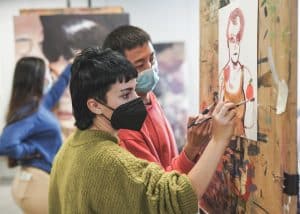The Most Prestigious Art Schools
Art is not just about creating visually pleasing expressions; it is a medium of communication that transcends cultural barriers and languages. For aspiring artists, joining an esteemed art school is often the first step towards not only honing their skills but also carving out a niche in this dynamic field. This article delves into the world of prestigious art schools, evaluating their importance, understanding how to select one, and gleaning an idea of their global distribution. We will also help you understand how to gain essential admission to these renowned institutions.
Understanding the Importance of Prestigious Art Schools
The world of arts is highly competitive, and joining a reputable institution gives students an edge over their competitors. It introduces them to a milieu of cultures and ideas, fostering a holistic development of their creative skills. Let’s understand the role of art schools and why prestige matters in art education.
The Role of Art Schools in Shaping Talent
Art schools serve as the crucible for shaping creativity and promoting cultural understanding. Renowned institutions not only invest in refining the technical skills of their students but also help them understand the philosophy and context behind each artistic expression. They challenge students to push boundaries and establish their unique voice in an art form.
Moreover, art schools provide a nurturing environment where students can experiment with different artistic mediums. Whether it’s painting, sculpture, photography, or digital art, these institutions offer comprehensive instruction and resources to help students explore their artistic potential.
Furthermore, art schools often organize workshops, seminars, and guest lectures by renowned artists and industry experts. These events expose students to diverse perspectives and techniques, expanding their artistic horizons and encouraging them to think outside the box.
Additionally, art schools foster a sense of community among students. Collaborative projects and group critiques allow students to learn from one another, exchange ideas, and develop a deeper appreciation for different artistic styles and approaches.
From instruction in various mediums to providing opportunities for meaningful collaborations, art schools play a significant role in honing an artist’s skill set. They provide a platform for students to display their work, receive critiques, continuously improve, and build networks with established artists and galleries.
The Impact of Prestige in Art Education
The reputation of an art school matters significantly in the trajectory of an art student’s career. Prestigious art schools maintain rigorous standards of teaching and have a faculty comprising renowned artists and scholars. Their faculty members not only possess exceptional technical skills but also have a deep understanding of the art industry and its trends.
Furthermore, prestigious art schools often have state-of-the-art facilities, well-equipped studios, and access to extensive art collections. These resources provide students with a conducive environment to experiment, innovate, and refine their artistic techniques.
Alumni from prestigious art schools have excelled in their fields, gaining recognition and winning awards, which adds to the school’s credibility and reputation. Their success stories inspire current students and give them a glimpse of what they can achieve with hard work, dedication, and the right education.
A degree from a prestigious art school demonstrates a commitment to excellence and high standards of artistic education. It opens up avenues for opportunities, creates connections in the art community, and often leads to high placement rates in rewarding careers.
Moreover, prestigious art schools often have strong ties with galleries, museums, and other art institutions. This allows students to showcase their work to a wider audience, participate in exhibitions, and establish professional connections that can propel their careers forward.
In conclusion, art schools play a crucial role in shaping the talent of aspiring artists. The prestige of an art school not only enhances the learning experience but also provides students with valuable networking opportunities and a competitive edge in the art industry. Choosing a prestigious art school can be a transformative step towards a successful and fulfilling career in the arts.
Criteria for Evaluating Art Schools
Choosing an art school is a crucial decision. It’s important to consider various aspects to ensure that your choice aligns well with your career aspirations. Here are some criteria for evaluating art schools.
Faculty and Staff Expertise
Education is greatly influenced by the quality of teachers. A team of well-rounded faculty enriched with diverse experiences and expertise contributes to a rich learning environment. They bring a wide range of perspectives, fostering creative exploration and critical thinking among students.
Many reputed institutions boast faculty members who are accomplished artists themselves. This is advantageous as students learn from the real-world experiences and career trajectories of these artists. The faculty’s ability to stay updated with the latest trends and techniques in the art world is also a determining factor.
Moreover, art schools with faculty members who actively engage in research and artistic practice outside of teaching can provide students with unique opportunities for collaboration and exposure to cutting-edge ideas.
Furthermore, the availability of support staff, such as studio assistants and technical experts, can greatly enhance the learning experience. These individuals can provide guidance and assistance in various aspects of art-making, from technical skills to material selection.
Curriculum and Specialization Areas
A strong curriculum tailored to the evolving landscape of art is important in an art school. The curriculum should cover foundational skills while promoting specialization in various art forms like painting, sculpture, photography, digital art, etc. A great art school encourages students to explore these avenues and find their unique style.
Renowned art schools update and adapt their curricula regularly, accommodating new technologies and advancements in the field of art. Therefore, when choosing a school, it’s crucial to look at the breadth and depth of the programs offered.
Additionally, a diverse range of elective courses and interdisciplinary opportunities can provide students with a well-rounded education. These offerings allow students to explore different mediums, collaborate with students from other disciplines, and gain a broader understanding of the art world.
Furthermore, art schools that provide access to state-of-the-art facilities and equipment, such as specialized studios, darkrooms, digital labs, and printmaking facilities, can greatly enhance the learning experience and enable students to experiment with different techniques and mediums.
Alumni Success and Reputation
Successful alumni concretize an art school’s reputation, enhancing its appeal to prospective students. Their accomplishments reflect the quality of education offered at the institution. Therefore, checking the success of the alumni network is an important consideration when assessing an art school.
Some top art schools maintain close ties with their alumni, resulting in beneficial networks for current students. Alumni often provide mentorship, internships, and job opportunities, making the transition from school to the professional art world smoother.
Furthermore, alumni who have achieved recognition in the art world can serve as role models and sources of inspiration for current students. Their achievements can demonstrate the potential career paths and possibilities that await graduates of the art school.
It is also worth considering the geographic distribution of alumni success. Art schools with alumni who have established themselves in different regions can provide students with a wider network and potential opportunities in various art communities.
Additionally, the reputation of an art school within the art industry and among employers can impact the value of a degree from that institution. Researching the reputation of an art school and its graduates in the professional art world can provide valuable insights into the potential career prospects associated with attending that school.
Geographic Distribution of Top Art Schools
Artistic influence and inspiration are often rooted in the cultural, social, and historical aspects of a place. Thus, the geographic location of an art school may impact a student’s learning experience. Let’s consider the distribution of prestigious art schools across the globe.
When exploring the geographic distribution of top art schools, it becomes evident that different regions offer unique opportunities for artistic growth and development. From North America to Europe and Asia, each continent boasts renowned institutions that nurture creativity and innovation.
Prestigious Art Schools in North America
The United States and Canada are home to numerous prestigious art schools. These institutions not only provide a solid foundation in artistic techniques but also foster a vibrant and diverse artistic community. Among the notable art schools in North America are the Rhode Island School of Design (RISD), the California College of the Arts (CCA) in the United States, and the Emily Carr University of Art and Design in Canada.
RISD, located in Providence, Rhode Island, is renowned for its interdisciplinary approach to art education. The school offers a wide range of programs, from painting and sculpture to industrial design and digital media. Students at RISD benefit from the school’s close proximity to Boston and New York City, allowing them to engage with thriving art scenes and connect with established artists and galleries.
On the West Coast, CCA in San Francisco and Oakland provides students with a dynamic environment that encourages experimentation and collaboration. The school’s emphasis on social justice and sustainability sets it apart, attracting students who are passionate about using art as a catalyst for positive change.
In Canada, the Emily Carr University of Art and Design, located in Vancouver, offers a comprehensive art education that combines traditional techniques with contemporary practices. The school’s proximity to the Pacific Northwest’s stunning landscapes and vibrant cultural scene provides students with endless inspiration.
Renowned Art Schools in Europe
Europe, known for its rich artistic and cultural heritage, has some of the world’s most prestigious art schools. These institutions have played a significant role in shaping the history of art and continue to provide exceptional education and artistic exploration. Among the renowned art schools in Europe are the École des Beaux-Arts in France and the University of the Arts London in the United Kingdom.
École des Beaux-Arts, located in Paris, France, has a storied history dating back to the 17th century. The school’s focus on classical artistic training has produced some of the most influential artists in history. Students at École des Beaux-Arts have the opportunity to study under esteemed faculty members and immerse themselves in the city’s vibrant art scene, which includes world-class museums and galleries.
In the United Kingdom, the University of the Arts London (UAL) stands as a leading institution for art and design education. UAL comprises several renowned colleges, including Central Saint Martins and the London College of Fashion. The school’s location in London, a global hub for creativity and innovation, provides students with access to a diverse range of cultural events, exhibitions, and industry connections.
Leading Art Schools in Asia
Asia, the largest continent in the world, hosts several top-tier art schools that reflect the region’s rich artistic traditions and contemporary practices. These institutions offer a unique blend of traditional techniques and cutting-edge approaches to art education. Notable art schools in Asia include the China Central Academy of Fine Arts and the Tokyo University of the Arts.
The China Central Academy of Fine Arts (CAFA), located in Beijing, is one of the most prestigious art schools in China. With a history spanning nearly 100 years, CAFA has cultivated generations of talented artists who have made significant contributions to the country’s art scene. The school’s curriculum combines traditional Chinese art forms with modern artistic practices, providing students with a comprehensive understanding of both.
In Japan, the Tokyo University of the Arts (Tokyo Geidai) stands as a leading institution for artistic education. Tokyo Geidai offers a wide range of programs, including fine arts, music, and design. The school’s commitment to fostering creativity and innovation has made it a hub for emerging artists in Japan and beyond.
Aspiring artists who choose to study at these Asian art schools not only benefit from the rich cultural heritage of the region but also gain exposure to the dynamic contemporary art scenes that are flourishing in cities like Beijing and Tokyo.
Gaining Admission into Prestigious Art Schools
Gaining admission to prestigious art schools is a competitive process, but with proper preparation and understanding of the process, you can enhance your chances of being selected. Let’s consider some key elements to focus on.
Preparing a Strong Portfolio
An art portfolio is essentially a collection of an artist’s best work, showcasing their talent, creativity, and versatility. A strong portfolio displays not only the technical ability of an artist but also their vision and style. The portfolio should include examples of various techniques and mediums, address different themes, display a keen sense of color and composition, and demonstrate the ability to think critically.
Understanding the Application Process
Applying to an art school entails more than just submitting a portfolio. Schools typically request personal statements, letters of recommendation, transcripts, and other documentation. It’s important to fully understand the application requirements and deadlines of each institution. Investing time in crafting compelling applications can greatly enhance the chances of admission.
Scholarships and Financial Aid Opportunities
Art schools often provide various scholarships and financial aid options. These may be based on merit, talent, diversity, financial need, or other criteria. Researching these opportunities and applying for relevant ones can help alleviate the financial burden of art education.
In conclusion, while identifying a prestigious art school is a challenging task, understanding the relevance, distribution, and admission processes of these institutions can simplify the decision-making process. Remember that the goal is to find a school that resonates with your artistic aspirations and paves the path toward your successful career in the immersive world of art.
How AdmissionSight Can Help You with College Admissions
AdmissionSight is a college consulting firm that provides personalized assistance to students throughout the college admissions process. Here are some ways that AdmissionSight can help you:
Admissions strategy: AdmissionSight can help you develop a strategic plan for your college application process. Our professional consultants can assist with identifying schools that are a good fit for your academic, extracurricular, and personal goals and help you plan and prioritize your application strategy.
Application review: AdmissionSight can review your application and provide feedback on how to improve it. We can offer suggestions on making your application stand out and highlighting your strengths and unique qualities.
Essay coaching: AdmissionSight can help you craft compelling essays that showcase your personality, goals, and achievements. We can guide you through the essay writing process and provide feedback on your drafts to help you refine your writing.
Interview preparation: AdmissionSight can provide interview coaching to help you feel confident and prepared for college interviews. Our experts can offer tips on how to present yourself professionally and how to answer common interview questions.
Extracurricular planning: AdmissionSight can help you plan and develop your extracurricular activities to make them more impactful and meaningful. We can suggest activities that align with your interests and goals and provide guidance on demonstrating your leadership and initiative.
Overall, AdmissionSight can provide valuable guidance and support throughout the college admissions process to help you maximize your chances of getting accepted into the college of your choice.
With a high success rate of over 75%, we have built a strong network in the past decade. Book an initial consultation today, free of charge!









































